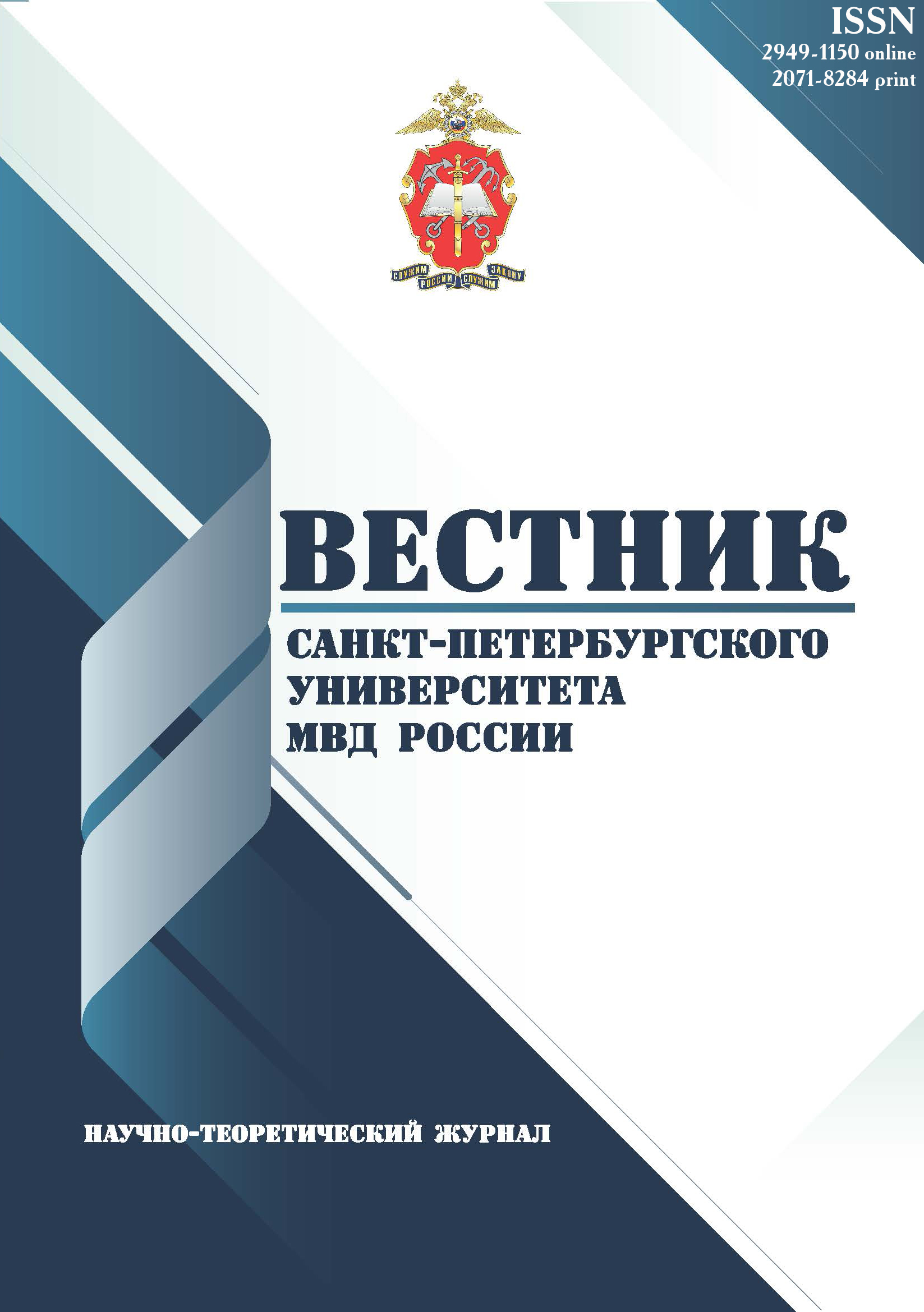from 01.01.2017 to 01.01.2023
Moscow, Russian Federation
UDC 342.9
CSCSTI 10.17
Russian Classification of Professions by Education 40.00.00
Russian Library and Bibliographic Classification 67401
Russian Trade and Bibliographic Classification 7535
BISAC BIO027000 Law Enforcement
Abstract: The article presents a comparative analysis of current approaches to the application of artificial intelligence (AI) in the sphere of control and supervisory activities by law enforcement agencies of foreign countries and Russia. The object of the study is normative acts, recommendations and other documents regulating the application of artificial intelligence in law enforcement, judicial practice, academic publications and analytical reports on the researched problem. The research methodology integrates a set of modern philosophical, general scientific, special scientific methods of cognition, including dialectical, systemic, structural-functional, hermeneutic, comparativelegal, formal-legal (dogmatic) and others. The study focuses on the implementation of a comparative legal study of the areas of application of AI in law enforcement. The research focuses on the development of unified approaches to regulating the use of AI and countering AI used in unlawful activities. The results of the comparative analysis revealed basic problems in the field of ensuring the accuracy of analytical tools used in the investigation of crimes and suppression of offences; considered theoretical and practical situations of application of artificial intelligence in law enforcement; studied some examples of deepfake technology application in illegal activities and mechanisms of counteraction to this technology. The author suggested additional compensatory legal measures to ensure the effective integration of artificial intelligence and its use for the purposes of law enforcement agencies of Russia.
artificial intelligence, comparative legal research, predictive law, public law, law enforcement practice
1. William P., Badholia A. Analysis of personality traits from text-based answers using HEXACO model // 2021 International Conference on Innovative Computing, Intelligent Communication and Smart Electrical Systems (ICSES). - IEEE, 2021. - S. 1-10.
2. William P., Badholia A. Evaluating Efficacy of Classification Algorithms on Personality Prediction Dataset // Elementary Education Online. - 2020. - T. 19. - № 4. - S. 3400-3413.
3. Bibave R. et al. A Comparative Analysis of Single Phase to Three Phase Power Converter for Input Current THD Reduction //2022 International Conference on Electronics and Renewable Systems (ICEARS). - IEEE, 2022. - S. 325-330.
4. Agamirov K. V. Problemy yuridicheskogo prognozirovaniya: metodologiya, teoriya, praktika : monografiya / pod nauch. red. R. V. Shagiyevoy. - Moskva: Yurkompani, 2015. - 406 s. - (Seriya «Aktual’nyye yuridicheskiye issledovaniya»).
5. Go A. et al. Twitter sentiment analysis // Entropy. - 2009. - T. 17. - 252 s.
6. Lima A. C. E. S., de Castro L. N. Automatic sentiment analysis of Twitter messages / 2012 Fourth International Conference on Computational Aspects of Social Networks (CASoN). - IEEE, 2012. - S. 52-57.
7. Vedaldi A., Fulkerson B. VLFeat: An open and portable library // Computer Vision Algorithms. ACMMM. - 2010. - S. 1469-1472. https://doi.org/10.1145/1873951.1874249.
8. Mavrinskaya T. V., Loshkarov A. V., Churakova Ye. N. Obezlichivaniye personal’nykh dannykh i tekhnologii «bol’shikh dannykh» (BigData) // Interaktivnaya nauka. - 2017. - № 16. - S. 78-80.
9. Pathan M. et al. Artificial cognition for applications in smart agriculture: A comprehensive review // Artificial Intelligence in Agriculture. - 2020. - T. 4. - S. 81-95.
10. Pandya R. et al. Buildout of methodology for meticulous diagnosis of K-complex in EEG for aiding the detection of Alzheimer’s by artificial intelligence // Augmented Human Research. - 2020. - T. 5. - S. 1-8. DOI:https://doi.org/10.1007/s41133-019-0021-6.
11. Musumeci F. et al. An overview on application of machine learning techniques in optical networks // IEEE Communications Surveys & Tutorials. - 2018. - T. 21. - № 2. - S. 1383-1408.
12. Judd J. S. Learning in networks is hard // Proc. of 1st International Conference on Neural Networks, San Diego, California, June 1987. - IEEE, 1987.
13. Panchiwala S., Shah M. A comprehensive study on critical security issues and challenges of the IoT world //Journal of Data, Information and Management. - 2020. - T. 2. - S. 257-278.
14. Simon A. et al. An overview of machine learning and its applications //International Journal of Electrical Sciences & Engineering. - 2016. - T. 1. - № 1. - S. 22-24.
15. Patel D., Shah D., Shah M. The intertwine of brain and body: a quantitative analysis on how big data influences the system of sports //Annals of Data Science. - 2020. - T. 7. - S. 1-16.
16. Batoyev V. B. «Bol’shiye dannyye (Big Data)» i prediktivnaya analitika v operativno-razysknoy deyatel’nosti: problemy ispol’zovaniya i puti resheniya // Vestnik Volgogradskoy akademii MVD Rossii. - 2020. - № 1 (52). - S. 11-17.
17. Sukhodolov A. P. i dr. Big data kak sovremennyy kriminologicheskiy metod izucheniya i izmereniya organizovannoy prestupnosti // Vserossiyskiy kriminologicheskiy zhurnal. - 2019. - T. 13. - № 5. - S. 718-726.
18. Dremlyuga R. I., Reshetnikov V. V. Pravovyye aspekty primeneniya prediktivnoy analitiki v pravookhranitel’noy deyatel’nosti // Aziatsko-Tikhookeanskiy region: ekonomika, politika, pravo. - 2018. - T. 20. - № 3. - S. 133-144.
19. Nikitin Ye. V. O novykh vozmozhnostyakh primeneniya sovremennykh tsifrovykh tekhnologiy v pravookhranitel’noy deyatel’nosti // Pravoporyadok: istoriya, teoriya, praktika. - 2018. - № 4 (19). - S. 55-59.
20. Pavlichenko N. V., Tambovtsev A. I. Budushcheye professii operupolnomochennyy - Big Data i analitika // Trudy akademii upravleniya MVD Rossii. - 2020. - № 2 (54). - S. 62-68.
21. Saini M., Kapoor A. K. Biometrics in forensic identification: applications and challenges // J Forensic Med. - 2016. - T. 1. - № 108. - S. 2. DOI:https://doi.org/10.4172/2472-1026.1000108.
22. Kindt E. J. Having yes, using no? About the new legal regime for biometric data // Computer law & security review. - 2017. - T. 34. - № 3. - S. 523-538. DOIhttps://doi.org/10.1016/j.clsr.2017.11.004.
23. Tistarelli M., Grosso E., Meuwly D. Biometrics in forensic science: challenges, lessons and new technologies //Biometric Authentication: First International Workshop, BIOMET 2014, Sofia, Bulgaria, June 23-24, 2014. Revised Selected Papers 1. - Springer International Publishing, 2014. - S. 153-164. DOIhttps://doi.org/10.1007/978-3-319-13386-7_12.
24. Zeinstra C. G. et al. Forensic face recognition as a means to determine strength of evidence: a survey // Forensic Sci Rev. - 2018. - T. 30. - № 1. - S. 21-32.
25. Bouchrika I. Evidence evaluation of gait biometrics for forensic investigation //Multimedia Forensics and Security: Foundations, Innovations, and Applications. - 2017. - S. 307-326. DOI:https://doi.org/10.1007/978-3-319-44270-9_13.
26. Brandon J. Terrifying high-tech porn: creepy’deepfake’videos are on the rise // Fox news. - 2018. - T. 20 [Electronic resource] // FoxNews : site - URL: https://www.foxnews.com/tech/terrifying-high-techporn-creepy-deepfake-videos-are-on-the-rise (date of treatment: 03.05.2023).
27. Liu M., Zhang X. Deepfake Technology and Current Legal Status of It //2022 3rd International Conference on Artificial Intelligence and Education (IC-ICAIE 2022). - Atlantis Press, 2022. - S. 1308-1314. DOI:https://doi.org/10.2991/978-94-6463-040-4_194.
28. Voigt P., Von dem Bussche A. The eu general data protection regulation (gdpr) // A Practical Guide, 1st Ed., Cham: Springer International Publishing. - 2017. - T. 10. - № 3152676. - 383 s. https://doi.org/10.1007/978-3-319-57959-7.
29. Minyasheva G. I. Vyyavleniye i raskrytiye moshennichestv, sovershayemykh s ispol’zovaniyem informatsionno-telekommunikatsionnykh tekhnologiy / Sovremennyye problemy ugolovnogo protsessa: puti resheniya sbornik materialov 3-y mezhdunarodnoy konferentsii / pod obshchey red. A. Yu. Terekhova. - Ufa: Izd-vo Ufimskogo yuridicheskogo instituta MVD Rossii 2022. - S. 191-197.
30. Zheludkov M. A. Izucheniye vliyaniya novykh tsifrovykh tekhnologiy na determinatsiyu moshennicheskikh deystviy (tekhnologiya deepfake) / Razvitiye nauk antikriminal’nogo tsikla v svete global’nykh vyzovov obshchestvu : sbornik trudov po materialam vserossiyskoy zaochnoy nauchnoprakticheskoy konferentsii s mezhdunarodnym uchastiyem. - Saratov, 2021. - S. 262-270.
31. Yugay L. Yu. Moshennichestvo s ispol’zovaniyem biometricheskikh tekhnologiy: sushchnost’, riski i mery protivodeystviya // Pravovyye voprosy protivodeystviya moshennichestvu i kiberprestupleniyam. - 2021. - T. 1. - № 1. - S. 59-63.
32. Rastoropova O. V. Protivodeystviye ispol’zovaniyu iskusstvennogo intellekta v prestupnykh tselyakh // Vestnik Universiteta prokuratury Rossiyskoy Federatsii. - 2021. - T. 4. - № 84. - S. 52-58.
33. Lemaykina S. V. Aktual’nyye voprosy protivodeystviya ispol’zovaniyu tekhnologii dipfeykov // Yurist»-Pravoved». - 2022. - № 3 (102). - S. 175-178.
34. Karpika A. G. Aktual’nyye voprosy sovershenstvovaniya pravovogo i tekhnicheskogo obespecheniya protivodeystviya prestupleniyam, sovershayemym s ispol’zovaniyem tekhnologiy iskusstvennogo intellekta // Filosofiya prava. - 2021. - № 3 (98). - S. 109-113.
35. Yastrebov O. A. Pravosub»yektnost’ elektronnogo litsa: teoretiko-metodologicheskiye podkhody // Trudy Instituta gosudarstva i prava Rossiyskoy akademii nauk. - 2018. - T. 13. - № 2. - S. 36-55.














